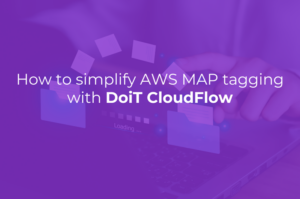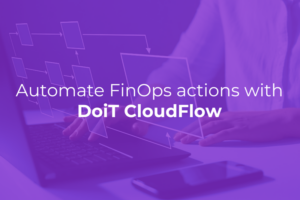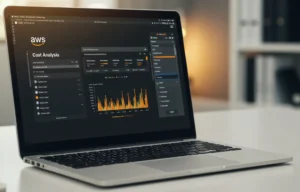Choosing the right cloud management platform is critical for any cloud-driven organization. Whether you’re a C-suite leader looking to reduce cloud costs and accelerate business growth, or a cloud architect focused on solving complex cloud challenges, the decision impacts both your operational efficiency and bottom line.
Cloud management platforms streamline cloud environments by offering visibility, control, and optimization across multicloud and hybrid cloud setups. With cloud usage scaling rapidly, so do the challenges—unnecessary spending, governance issues, and inefficient use of computing resources.
That’s why understanding the key features and benefits of cloud management software is essential.

In this guide, we’ll walk through everything you need to know about choosing the right cloud management solutions, from cost management and reduction to anomaly detection, cloud analytics, and more. These are areas where platforms like DoiT Cloud Intelligence™ and innovative tools like DoiT Flexsave™ and BigQuery Lens can offer significant advantages.
Whether you’re looking to optimize cloud spending or future-proof your cloud infrastructure, this guide will provide the insights and best practices you need to make informed decisions.
What is a cloud management platform?
A cloud management platform (CMP) is a suite of tools designed to give organizations greater control and visibility over their cloud environments and cloud computing resources.
Integrating across multiple cloud providers helps CMPs centralize the management of resources, optimize costs, and ensure you meet governance and cloud security standards and goals.
For cloud engineers, a CMP provides the technical control needed to optimize performance, automate tasks, and monitor usage. Meanwhile, C-suite leaders rely on CMPs to ensure that cloud investments align with business goals, such as cost reduction and accelerated growth.
Every organization’s needs are different. The right cloud management platform should empower you to tackle infrastructure management efficiently and cloud cost optimization, while also driving innovation. In the following sections, we’ll explore the key features to look for in a cloud management platform and how they can enhance both operational and financial outcomes.
4 key features of comprehensive cloud management tools
Choosing the right cloud management platform means understanding the key features that will best support your organization’s needs. Below are four essential functionalities that any effective solution should offer, helping you navigate today’s increasingly complex cloud environments.
1. Cost management and optimization
Cloud costs can spiral out of control if not managed properly. A powerful cloud management platform will provide tools for tracking, forecasting, and doing real-time cloud cost optimization.
Features like cost allocation by department, automated recommendations for rightsizing resources, and predictive cost models can significantly reduce unnecessary spending.
Rightsizing, for instance, involves analyzing usage patterns and adjusting resources to the most efficient size. If you’re over-provisioning virtual machines or storage, your costs can quickly skyrocket. A CMP can help by identifying underutilized or over-provisioned resources and offering recommendations to scale them up or down based on actual usage.
Power scheduling allows businesses to save even more by shutting down nonessential resources, such as development or test environments, during off-hours. A CMP can automate this process, ensuring resources are only running when they’re needed, further cutting unnecessary spending.
Deleting idle or unused resources—like forgotten databases or orphaned storage volumes—is another key strategy. These resources can accumulate over time, resulting in hidden costs that can add up significantly. CMPs often provide visibility into these unused assets and automate their removal, ensuring your cloud environments remain efficient.
For example, DoiT Cloud Intelligence™ offers robust FinOps functionality, helping organizations control and optimize multicloud usage while eliminating waste. Without these types of tools, organizations risk accumulating wasted cloud spend, which can account for a significant chunk of overall costs.
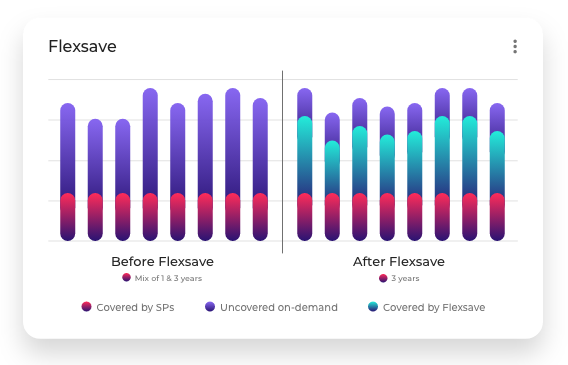
DoiT Flexsave™ uses machine learning to apply discount rates on applicable workloads. (Source)
Cost savings for discount programs
Many organizations waste their cloud spend due to mismanaged resources. DoiT’s cost optimization tools like DoiT Flexsave™ further enhance savings by automating AWS Savings Plans and maximizing compute discounts.
2. Multicloud management
Managing cloud resources across Amazon Web Services (AWS), Google Cloud, and Azure is a foundational feature of any cloud management platform.
However, it’s often challenging for organizations to understand the major drivers of their overall cloud footprint across different cloud service providers (CSPs). Each provider categorizes and describes costs differently, making it difficult to gain a clear, consolidated view of where and how resources are being consumed. Having a tool that can normalize these costs across providers is essential to understanding them holistically and making informed decisions.
Since 89% of companies now use a multicloud approach, this highlights the demand for integrated solutions that provide visibility and control across these platforms.
With organizations adopting a mix of public cloud services, a multicloud approach ensures that you can allocate workloads to the most efficient or cost-effective provider. However, balancing and optimizing resources across these environments can be complex without the right tools, as differences in pricing models, service availability, and performance metrics can lead to inefficiencies and increased costs if not managed effectively.
While private clouds may still play a role in certain industries, many organizations leverage public clouds like AWS and Google Cloud for their flexibility and scalability.
Tools like DoiT Cloud Intelligence™ help streamline this process by simplifying multicloud management and optimizing cloud spend.
3. Automation and orchestration
As cloud environments grow, so does the need for automation. IT teams often find themselves bogged down in repetitive, manual tasks, spending hours on activities like provisioning new resources, managing scaling, and monitoring performance. This drains valuable time and leads to frustration, burnout, and a lack of focus on strategic initiatives that drive innovation and growth.
Without effective automation, organizations risk increased human error, which can result in misconfigured resources, unexpected outages, and spiraling costs. The consequences of these inefficiencies can be severe, impacting service delivery and customer satisfaction while diverting resources away from essential projects. In a fast-paced business environment, this struggle can leave teams feeling overwhelmed and reactive rather than proactive.
Cloud management tools should offer built-in automation and orchestration tools that handle these critical tasks, enabling teams to optimize their cloud infrastructure effortlessly. For instance, by implementing autoscaling applications, resources can automatically adjust based on real-time demand, ensuring optimal performance without the need for manual intervention. This means that during peak usage, additional resources are deployed instantly, while during off-peak times, they are scaled back to save costs.
DoiT’s suite of tools complements automation strategies by enabling faster, smarter deployment. For example, using infrastructure-as-code (IaC) practices, teams can define their infrastructure in code, allowing for rapid deployment and consistent configurations across environments.
This not only accelerates the rollout of new features and services but also minimizes the risks associated with human error, making the entire process more efficient and reliable.
4. Security and compliance
With the rapid expansion of cloud environments, maintaining security and compliance becomes more challenging.
Security breaches or compliance violations can lead to severe financial penalties, data loss, and reputational damage, while the increasing complexity of cloud ecosystems makes it harder to monitor access, protect sensitive data, and ensure consistent enforcement of policies across multiple environments.
A cloud management solution should include tools for monitoring vulnerabilities, managing access controls, and ensuring that your organization remains compliant with industry standards like the following:
- General Data Protection Regulation (GDPR)
- Health Insurance Portability and Accountability Act (HIPAA)
- Service Organization Control 2 (SOC 2)
Security also involves regular updates, patches, and real-time monitoring to ensure that all cloud instances are safeguarded against threats.
Depending on the provider, you may also be able to take advantage of additional layers of support. For example, DoiT’s team of senior cloud architects can provide expert guidance on how to ensure your cloud environment remains secure and compliant without adding unnecessary complexity.
Key benefits and features of a cloud management platform
A cloud management platform (CMP) offers significant advantages that can drive efficiency, cost savings, and better governance for organizations navigating complex cloud environments. Here are the essential features and benefits to look for when choosing the right CMP:
Cost management tools and savings
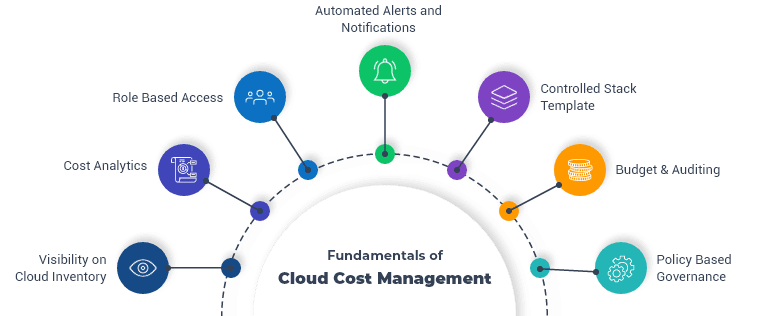
The cloud cost management fundamentals include visibility on cloud inventory and cost metrics (Anblicks)
According to the Wall Street Journal, 82% of enterprises struggle to manage their cloud spend effectively. One of the most immediate benefits of a CMP is the ability to reduce cloud costs. Look for robust financial management features like cost tracking, forecasting, and optimization recommendations.
Additionally, cloud providers offer discount programs, such as Savings Plans (SPs) and Reserved Instances (RIs), which allow businesses to significantly reduce compute costs by committing to longer-term usage. Despite these available programs, 35% of enterprise cloud spending is often wasteful, largely due to underutilized resources, failure to leverage discounts, and inefficient workloads.
With accurate cost tracking and forecasting, you can proactively manage budgets, avoid surprise expenses, and allocate resources more strategically, ultimately improving financial planning and long-term sustainability.
Climate risk data and analytics provider Climate X reduced its cloud costs by 17% with DoiT Architecture Review on AWS. The company’s new infrastructure is more resilient and capable of accommodating customer needs, and it anticipates being able to meet user demands for the next 18 to 24 months.
Multicloud support and flexibility
A strong CMP enables seamless management of resources across multiple public clouds like AWS, Google Cloud, and Azure.
This multicloud flexibility prevents vendor lock-in and allows your business to take advantage of each provider’s unique strengths. It also helps avoid management headaches, respond to service outages, and remain agile in a changing cloud landscape—giving you a competitive edge in both stable and uncertain times.
Scalability and automation
The best CMPs support seamless scalability, allowing businesses to efficiently expand or contract cloud resources based on need. Automation features—such as deployment, scaling, and maintenance—reduce manual intervention, boost efficiency, and lower operational costs.
Platforms with orchestration capabilities automatically adjust resources to align with performance demands, allowing teams to focus on innovation rather than repetitive tasks.
Centralized governance
Managing multiple cloud environments can become chaotic without the right governance tools, leading to inconsistencies, security vulnerabilities, and uncontrolled costs. A CMP provides centralized control over policies, access management, and compliance, ensuring uniformity and reducing the risk of mismanagement.
Policies: Without centralized governance, enforcing consistent policies across cloud platforms can be difficult, resulting in gaps that expose the organization to security breaches and noncompliance. The top CMPs ensure that security, usage, and cost policies are applied uniformly, reducing the chances of critical oversights.
Access management: As cloud environments grow, managing who has access to what resources can become overwhelming. Poor access management can lead to unauthorized access, insider threats, or data breaches. Centralized governance allows for streamlined, role-based access control, ensuring only the right people have permission to critical resources.
Compliance: Different cloud environments may require varying compliance standards. Managing this manually increases the risk of noncompliance, which can result in regulatory penalties. The best CMPs simplify this process by automating compliance monitoring and ensuring that all environments meet industry standards.
Security and compliance features
With the expansion of cloud environments, security and compliance become harder to manage. A CMP with strong security features—such as encryption, identity management, and compliance monitoring—mitigates the risks of breaches and costly fines. These features protect your data and ensure adherence to industry standards, building customer trust while maintaining regulatory compliance.
Enhanced efficiency through automation
CMPs with automation capabilities reduce the need for manual intervention in deployment, maintenance, and scaling tasks. This increases operational efficiency and frees up your engineering team to focus on innovation.
For example, DoiT’s client Bringg improved efficiency by 30% thanks to the machine learning capabilities it added to its workflows via Google Cloud Platform.
Increased cloud visibility with customized reporting
Full visibility into your cloud environments is essential for data-driven decision-making. A CMP that consolidates performance, usage, and cost data across all platforms helps you identify inefficiencies and optimize cloud strategy over time.
Customizable reporting is an important feature that allows granular analysis of costs, performance trends, and resource consumption by team or project, ensuring your cloud operations align with business objectives.
For example, having granular visibility into resource consumption by team, project, or service allows you to identify inefficiencies, such as underutilized instances or unexpected cost spikes. Insights into regional cloud usage could also inform decisions about workload distribution, ensuring optimal performance and cost efficiency across global environments.
User experience and support
A CMP should simplify—not complicate—your cloud management processes. Additionally, look for a provider with comprehensive support, training, and consulting services, like DoiT offers, to ensure you’re getting the most out of your platform.
A user-friendly platform reduces the learning curve for your team, allowing you to quickly implement and optimize cloud operations, while reliable support ensures you’re never left dealing with issues on your own.
Selecting tools for cloud cost management
Effectively managing cloud costs is critical to maintaining a sustainable and scalable cloud environment.
As cloud usage grows, so does the complexity of tracking and optimizing costs. DoiT provides a suite of advanced solutions designed to help you manage, reduce, and optimize your cloud spend across AWS, Google Cloud, and Azure while offering expert support to guide you through the process.
Centralize cost management with DoiT DataHub
DoiT DataHub empowers cloud-driven organizations to consolidate all their IT costs—including third-party data—into a single platform. This includes cloud expenses from providers like AWS, Google Cloud, and Microsoft Azure, as well as costs associated with SaaS applications, on-premises infrastructure, maintenance fees, and vendor services. DataHub provides detailed insights and enables you to create unit economics for deeper financial analysis.
By offering a comprehensive view of all your costs in one place, DataHub allows for informed decision-making, ensuring you stay on top of your cloud expenses while planning for future growth.
Automate savings with DoiT Flexsave™
For organizations using AWS, DoiT Flexsave™ is a powerful tool that automates the management of AWS Savings Plans, offering significant savings without the need for long-term commitments or complex manual forecasting.
Managing AWS Savings Plans or Reserved Instances manually can involve time-consuming tasks like tracking usage, predicting future compute needs, and aligning those forecasts with the appropriate financial commitments. These processes often result in financial risks such as overcommitment, commitment conflicts, or paying penalties for underutilized resources. For instance, with Reserved Instances, even if you’re not using the committed resources, you’re still locked into paying for them.
With DoiT Flexsave™, these risks become irrelevant. The tool continuously monitors your AWS workloads and optimizes savings by automatically adjusting coverage in real-time—whether for Savings Plans or Reserved Instances—ensuring that you only pay for what you actually use. Unlike traditional AWS discount programs that require up-front payments or fixed commitments, DoiT Flexsave™ eliminates lock-in risk, making it ideal for unpredictable workloads.
This type of automated savings optimization frees up your time to focus on higher-priority initiatives while keeping your cloud infrastructure cost-efficient, with no up-front costs or long-term financial commitments required.
Gain insight with DoiT Anomaly Detection
DoiT Anomaly Detection alerts you to unusual cloud behavior, such as sudden spikes in resource usage, unexpected increases in data transfer costs, or unusual activity patterns from specific accounts.
With real-time notifications and detailed analytics, you can quickly identify these anomalies and take immediate action—whether it’s reallocating resources, adjusting service configurations, or investigating specific accounts. This lets you safeguard your budget against unpredictable changes before they escalate into significant issues.
DoiT’s suite of cloud management and cost optimization tools ensures that your cloud infrastructure operates at peak efficiency while minimizing unnecessary costs. By combining automated tools with expert guidance, you can confidently manage your cloud ecosystem and reinvest savings into business innovation and growth.
Ready to optimize your cloud and reduce costs?
DoiT is here to help you reduce cloud costs and accelerate business growth with a comprehensive suite of cloud optimization products and services. Start driving efficiencies and scaling your cloud strategy today.
Discover how you can reduce cloud costs and accelerate development and business growth with DoiT's suite of cloud optimization products and services.
Book a discovery call with DoiT today

